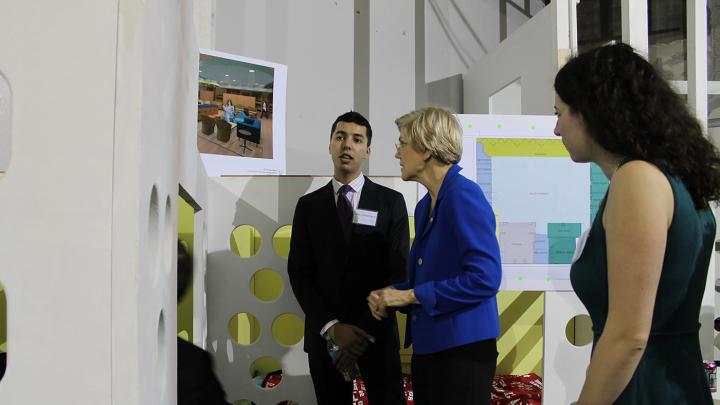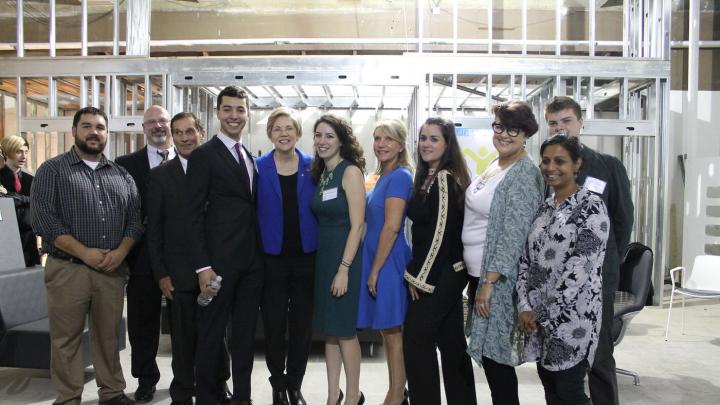More than 500 people filled the chapel at First Parish Church in Cambridge last Friday afternoon to celebrate the opening of Y2Y Harvard Square, a homeless shelter for young people founded by Sam Greenberg ’14 and Sarah Rosenkrantz ’14. There were thanks and praise and giddy eruptions of applause, a vocal quartet singing “Lay Up Your Treasures in Heaven,” and a gospel artist belting out Mariah Carey’s “Hero” to a grand-piano accompaniment. There were rousing speeches and performance poetry, a presentation of awards, and, amid an interfaith blessing, a bright string of origami cranes unveiled from a Tupperware container by John Bach, the Quaker chaplain at Harvard.
One of several public officials to offer remarks, U.S. senator Elizabeth Warren kicked off the event by telling the audience that any given night in this country sees an estimated 39,000 youths homeless, and that 20 to 40 percent of them are LGBTQ. “Which means,” she said, “it’s a pretty tough street out there.” Turning to Greenberg and Rosenkrantz, she continued: “They saw the problem. They had a vision for how to fix it, and that’s what’s going on downstairs. And I’ve got to tell you—it is beautiful.”
The shelter—scheduled to open in the church basement in December, just as winter descends—will offer 22 gender-inclusive beds for 18- to 24-year-olds, each of whom may stay up to a month as they transition their way out of homelessness. The renovation project was designed by Studio G of Jamaica Plain; construction firms Skanska USA and Essex Newbury donated their services. A $1.25-million fundraising campaign for the shelter reached its goal just last week.
Y2Y has been more than two years in the making. As undergraduates, Greenberg and Rosenkrantz volunteered at Harvard Square Homeless Shelter, a 24-bed, student-run emergency shelter for adults. They noticed that the organization had to turn away dozens of would-be volunteers (there wasn’t enough work for them to do) and many homeless people—among them young adults—because there wasn’t enough room for them to sleep. That’s when the two started laying plans for Y2Y. After they graduated, they began working full time as co-directors of the project. Said Warren, “The key is local people saying, ‘I may not be able to fix it all; I may not be able to take on all 39,000 homeless youth. But what we can do is, we can make a start right here in Cambridge.’ And by making a start, we make a real difference, person to person.”
A program of Harvard’s Phillips Brooks House Association, Y2Y Harvard Square is the nation’s only student-run overnight shelter for young adults. It fills a critical gap: although the AIDS Action Committee of Massachusetts offers daytime services for homeless youth—space, food, laundry, showers, and a range of social and medical services—there has been no place in Cambridge for young people, who often feel unsafe at adult shelters, to spend the night.
At the opening event, Jamila Bradley, a Y2Y youth advocacy coordinator, explained how much it means to have a brick-and-mortar shelter for people her age. When she first moved to Boston from her native Florida, she said, “I was enamored by the brick.” The buildings were solid, sturdy, permanent—“a place built to last.” She craved that stability when, almost two years ago, she found herself sitting in the dining hall of First Parish Church, “realizing that I had less family to turn to than I expected, fresh from a violent assault, and new to the world of youth homelessness.”
Other young speakers and Y2Y co-organizers offered their own stories of homelessness (“Oftentimes when you’re on the street as a young person, hope is the very first thing that you lose,” one said), and reiterated how important the shelter’s solid walls would have been to them and will be to others. They called it an amazing triumph, and a long time coming. “Generally when I speak to grantees, legislators, or even care-providers,” Bradley said, “I speak with a candor and transparency that I think they’re entitled to, despite the fact that it betrays my anger. But today isn’t like that, and it’s refreshing.”
As the celebration wound to a close, Greenberg and Rosenkrantz took the podium, to a standing ovation and a cascade of cheers. They spent several minutes thanking everyone they could think of, and then Greenberg looked up at the crowd filling the balconies and side aisles and said, “And yet, the real work starts when we open next month, when there are 22 meals to serve every night, when there are hundreds of dishes to wash, when there are bags of laundry to fold. When we open next month, we will have a sanctuary to create, momentum to sustain, and I think most importantly, a future to build. In a lot of ways, our journey is just getting started.”









